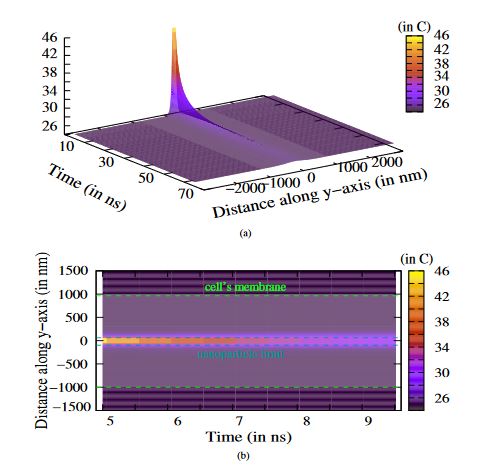ABSTRACT
A commonly used therapy for cancer is based on the necrosis of cells induced by heating through the illumination of nanoparticles embedded in cells. Recently, the photoacoustic pressure shock induced by the illumination pulse was proved and this points to another means of cell destruction. The purpose of this study is to propose a model of the photoacoustic pressure in cells.
The numerical resolution of the problem requires the accurate computation of the electromagnetism, the temperature and the pressure around the nanostructures embedded in a cell. Here, the problem of the interaction between an electromagnetic excitation and a gold nanoparticle embedded in a cell domain is solved. The variations of the thermal and photoacoustic pressures are studied in order to analyze the pressure shock wave inducing the collapse of the cell’s membrane in cancer therapy.
PHOTOACOUSTIC MODEL
This section presents the physical model and the numerical method used to solve the photoacoustic problem. The photoacoustic or thermoacoustic process refers to the generation of acoustic waves by absorption of electromagnetic energy.
NUMERICAL RESULTS AND DISCUSSION

Figure 3. (a) Time evolution of the temperature

Figure 4. (a) Time evolution of the variation of the pressure
That contrasts with the temperature propagation (see Figure 3a,b) that is mainly located in the near vicinity of the gold nanoparticle (i.e., only a few nanometers from the gold nanoparticle, corresponding to the spatial expansion of the nanoparticle along the y-axis: − 50 to 50 nm). Therefore, only the nearest zone around the nanoparticle sees the temperature elevation. Figure 4 illustrates that the cell’s membrane is receiving a pressure shock wave (i.e., the variation of pressure is non vanishing at the position of the cell membrane).
CONCLUSIONS
The paper focuses on the analysis of the direct 3D numerical computation of the time-dependant photoacoustic pressure of a gold nanoparticle embedded in a cell. The adaption of the computation process was achieved to optimize both the temperature amplitude and the propagation of the acoustic wave pressure. The variation of the pressure at the limit of the cell’s membrane relative to the time of excitation is presented.
We discuss the ability of the use of pressure to disrupt the cell membrane, which can be an alternative way to induce lysis of the membrane. The use of complex particles or cell shapes can extend the domain of its application, especially to the study and the design of a pressure-based non invasive theragnostic for cancer.
Source: University of Technology
Authors: Thomas Grosges | Dominique Barchiesi